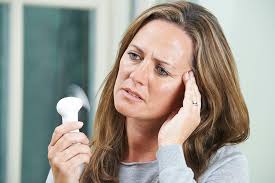Menopause is a natural phase in a woman’s life, marking the end of her reproductive years. While it is a normal biological process, the symptoms associated with menopause can be challenging for many women. From hot flashes and mood swings to sleep disturbances and weight gain, the journey through menopause can be tumultuous. However, there are various strategies and treatments available that can provide much-needed relief during this transitional phase. In this blog, we’ll delve into the intricacies of menopause relief and explore effective solutions to help women navigate this significant life stage.
Contents
What is Menopause?

Menopause is a natural biological process that marks the end of a woman’s reproductive years. It is defined as the permanent cessation of menstrual periods and fertility, and it typically occurs in midlife, usually between the ages of 45 and 55. Menopause is a normal part of the aging process, and it is a result of the gradual decline in the production of reproductive hormones, particularly estrogen and progesterone, by the ovaries.
The transition to menopause is a gradual process and is often divided into three stages:
- Perimenopause: This is the period leading up to menopause, usually starting in a woman’s 40s. During perimenopause, the ovaries gradually produce less estrogen, and menstrual cycles may become irregular. Women may experience symptoms such as hot flashes, night sweats, mood swings, and changes in libido during this stage.
- Menopause: Menopause is defined as when a woman has not had a menstrual period for 12 consecutive months. At this stage, the ovaries have significantly reduced their production of estrogen and progesterone, leading to the cessation of menstrual cycles and the end of fertility.
- Postmenopause: Postmenopause refers to the years following menopause. During this stage, many of the symptoms that were experienced during perimenopause diminish, although some, like vaginal dryness and bone density loss, may persist. Postmenopausal women are at an increased risk of certain health conditions, such as osteoporosis and heart disease, due to the decline in estrogen levels.
Different Menopause Relief Methods
There are various methods and approaches to alleviate the symptoms associated with menopause. The choice of relief methods often depends on individual preferences, health considerations, and the severity of symptoms. Here are different menopause relief methods:
Vaginal Moisturizers and Lubricants
Vaginal moisturizers and lubricants are products designed to address issues related to vaginal dryness, a common symptom experienced by women during and after menopause. These products can provide relief from discomfort and enhance sexual well-being. It’s essential to understand the differences between vaginal moisturizers and lubricants and how to use them effectively.
Vaginal Moisturizers:
- Purpose: Vaginal moisturizers are designed for long-term relief of vaginal dryness. They are usually applied regularly, regardless of sexual activity, to maintain vaginal moisture and comfort.
- Ingredients: Common ingredients include water, glycerin, hyaluronic acid, and aloe vera. Some moisturizers may also contain oils or silicone-based compounds.
- How to Use: Apply a small amount of the moisturizer to the vaginal area, usually with an applicator, before bedtime or as directed by the product instructions. Regular use, typically a few times a week, helps maintain vaginal hydration.
Medications

Various medications can be prescribed or recommended to manage specific symptoms associated with menopause. It’s important to note that the choice of medication depends on individual health, symptoms, and considerations. Always consult with a healthcare provider before starting any new medication. Here are some common medications used for menopause relief:
Selective Serotonin Reuptake Inhibitors (SSRIs) and Serotonin-Norepinephrine Reuptake Inhibitors (SNRIs):
- Purpose: Antidepressant medications, such as SSRIs (e.g., fluoxetine, paroxetine) and SNRIs (e.g., venlafaxine), may be prescribed to manage mood swings and hot flashes.
- Benefits: Can help alleviate mood symptoms and reduce the frequency and intensity of hot flashes.
- Considerations: These medications may have side effects and interactions with other drugs. Consultation with a healthcare provider is essential.
Gabapentin and Pregabalin:
- Purpose: Originally developed to treat seizures, these medications are sometimes used to manage hot flashes.
- Benefits: May reduce the frequency and severity of hot flashes.
- Considerations: Side effects and potential interactions with other medications should be discussed with a healthcare provider.
Ospemifene and Conjugated Estrogens/Bazedoxifene:
- Purpose: These medications are used to address vaginal dryness and painful intercourse.
- Benefits: Ospemifene helps increase vaginal lubrication, and conjugated estrogens/bazedoxifene provides estrogen replacement therapy for postmenopausal women with a uterus.
- Considerations: Potential risks and benefits, including the risk of blood clots, should be discussed with a healthcare provider.
Bisphosphonates:
- Purpose: Used to prevent or treat osteoporosis, which becomes more common after menopause due to bone density loss.
- Benefits: Helps maintain bone density and reduce the risk of fractures.
- Considerations: Long-term use may have side effects, and the decision to use bisphosphonates should be based on an individual’s bone health assessment.
Natural and Lifestyle Modifications

Natural and lifestyle modifications play a significant role in managing menopausal symptoms and promoting overall well-being during this life stage. Incorporating healthy habits and making mindful choices can help alleviate discomfort and enhance the quality of life for women experiencing menopause. Here are several natural and lifestyle modifications to consider as menopause relief:
Dietary Changes:
- Increase Calcium and Vitamin D Intake: These nutrients are essential for maintaining bone health. Include dairy products, leafy green vegetables, and fortified foods in your diet.
- Phytoestrogen-Rich Foods: Foods containing phytoestrogens, such as soy, flaxseeds, and legumes, may provide mild relief from hot flashes and other symptoms.
Regular Exercise:
- Aerobic Exercise: Engage in regular aerobic activities like walking, jogging, swimming, or dancing to improve cardiovascular health and mood.
- Strength Training: Include strength training exercises to maintain muscle mass and bone density.
- Yoga and Stretching: These activities can improve flexibility, reduce stress, and promote relaxation.
Stress Management:
- Mindfulness and Meditation: Practice mindfulness techniques and meditation to reduce stress and promote emotional well-being.
- Deep Breathing Exercises: Incorporate deep breathing exercises to manage anxiety and improve relaxation.
Adequate Sleep:
- Establish a Sleep Routine: Create a consistent sleep schedule and establish a relaxing bedtime routine to improve sleep quality.
- Create a Comfortable Sleep Environment: Ensure your bedroom is conducive to sleep by keeping it cool, dark, and quiet.
Hydration: Staying well-hydrated is crucial for overall health and can help alleviate symptoms like dry skin and mucous membranes.
Quit Smoking and Limit Alcohol:
- Smoking Cessation: Quit smoking to reduce the risk of cardiovascular issues and improve overall health.
- Moderate Alcohol Consumption: Limit alcohol intake, as excessive alcohol can disrupt sleep and contribute to other health issues.
Acupuncture and Alternative Therapies:
- Acupuncture: Some women find relief from symptoms like hot flashes through acupuncture, a traditional Chinese medicine practice.
- Herbal Remedies: Certain herbs, such as black cohosh and red clover, are believed to have mild benefits for menopausal symptoms. Consult with a healthcare provider before using herbal supplements.
Maintain a Healthy Weight:
- Balanced Diet: Adopt a balanced and nutritious diet to help manage weight and promote overall health.
- Regular Physical Activity: Combine healthy eating habits with regular physical activity to maintain a healthy weight.
It’s important to note that the effectiveness of these natural and lifestyle modifications can vary among individuals. Additionally, before making significant changes, especially when considering herbal supplements or alternative therapies, it’s advisable to consult with a healthcare provider to ensure that the chosen approach is safe and appropriate based on individual health considerations.
Surgery

In some cases, women may consider surgical options to address specific issues related to menopause. It’s essential to note that surgery is typically considered when other conservative treatments have failed or when there are unique health considerations. Here are a couple of surgical interventions related to menopause:
Hysterectomy:
- Description: A hysterectomy is a surgical procedure that involves the removal of the uterus. Depending on the type of hysterectomy, the surgeon may also remove the cervix, ovaries, and fallopian tubes.
- Indications: Hysterectomy may be recommended for various reasons, including uterine cancer, severe uterine fibroids, endometriosis, or other conditions causing significant pelvic pain or bleeding.
- Impact on Menopause: If both ovaries are removed during the hysterectomy (bilateral oophorectomy), menopause is induced immediately, as the ovaries are the primary source of estrogen. If the ovaries are left intact, menopause will occur naturally at the usual age.
Oophorectomy (Ovarian Removal):
- Description: Oophorectomy involves the surgical removal of one or both ovaries.
- Indications: This procedure may be performed due to ovarian cancer, the presence of ovarian cysts, or to reduce the risk of developing ovarian cancer in women at high risk. It can also be part of a hysterectomy.
- Impact on Menopause: Removal of both ovaries induces menopause immediately. If only one ovary is removed, the other ovary (if healthy) continues to produce hormones, and menopause occurs when the remaining ovary stops functioning, typically later.
Laparoscopic Surgery for Endometriosis:
- Description: Laparoscopic surgery is a minimally invasive procedure used to diagnose and treat endometriosis, a condition where tissue similar to the lining of the uterus grows outside the uterus.
- Indications: Laparoscopic surgery may be recommended for women with severe endometriosis that does not respond to other treatments, causing significant pain or fertility issues.
- Impact on Menopause: While this surgery doesn’t induce menopause, it can provide relief from symptoms associated with endometriosis.
Individuals must thoroughly discuss with their healthcare providers before considering any surgical intervention. The decision to undergo surgery should take into account the specific health condition, potential risks and benefits, and the impact on hormonal balance and menopausal symptoms.
Conclusion
In conclusion, managing menopausal symptoms is a multifaceted journey that encompasses various approaches, including medical interventions, natural remedies, and lifestyle modifications.
The transition through menopause is unique to each woman, and finding the right combination of strategies is crucial for promoting physical and emotional well-being during this significant life stage.
If you are facing menopause related issues, menopause treatment at HerMantra can help. Book your free trial online menopause treatment session now.


